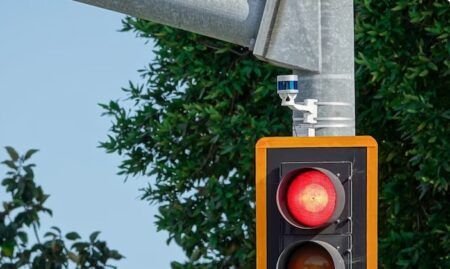In preparation for the Intelligent Transport Systems (ITS) World Congress in 2021, the German city of Hamburg, in partnership with Audi, Here Technologies and Swarco, has successfully completed tests of a traffic light phase assistant system.
Initiated by Swarco and Here Technologies, and part of the wider Mobility Partnership between the Volkswagen Group and the City of Hamburg, the project aimed to test if traffic flow and vehicle emissions could be improved by providing drivers with information about the color phase of traffic lights on the road ahead.
The pilot also studied whether the relevant real-time infrastructure data from a network of connected intersections could be managed efficiently by a cloud-based platform, and then be delivered to drivers through existing mobile cellular 3G/4G/LTE communications channels.
More than 60 traffic lights in the city were equipped with the technology, and drivers on the test routes tracks were shown how fast they should drive to avoid having to stop at a red traffic light, creating a ‘green wave’. If this could not be achieved within the permitted speed limit, an in-car countdown displays the time until the next green phase.
The trials proved that the technology could optimize traffic flow, shorten driving times, and cut vehicle emissions by reducing unnecessary deceleration, stopping and accelerating away from traffic lights.
By making the traffic light data available to developers, service providers and auto makers in the future, all road users, including cyclists and pedestrians, could benefit from the information through in-car navigation and assistance services or smartphone applications.
For the joint project, the city of Hamburg provided the traffic light location, timing and raw traffic data. Swarco’s traffic management software produced individual timing forecasts. Here provided its low-latency cloud-based Open Location Platform, which coordinated the raw data, and communicated Swarco’s forecasts along with maps of complex intersections to the Audi fleet via a cellular communications interface.
Audi’s test fleet was equipped with the ‘Traffic Light Information’ service, which was first launched in the USA in 2016, and is already available in several US cities. Following the successful findings of the pilot project, the State Roads, Bridges and Waters Department (LSBG) will apply for funding from the federal government so that city-wide data can be used to provide green-time forecasts for more than 1,000 traffic lights in the future.
“The traffic light phase assistant exemplifies the synergies that can arise through increased cooperation between the public and private sectors,” noted Michael Bültmann, managing director of Here Deutschland. “In addition, the pilot project has been successful in demonstrating that it is technically possible to transfer urban data to third-party applications through a cloud-based platform, such as our Open Location Platform, and low-latency mobile data networks.”
Frank Horch, Hamburg’s Senator for Economics, Transport and Innovation, commented, “The traffic light time forecast in the vehicle is an excellent example of how our cooperation with industrial partners at eye level is the right choice; everyone has contributed with their strengths and core competencies. As a result, we have a development that works, is innovative, and offers road users real added value.”




